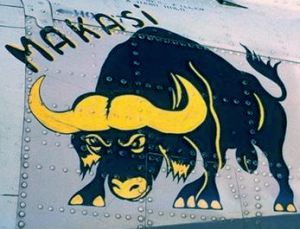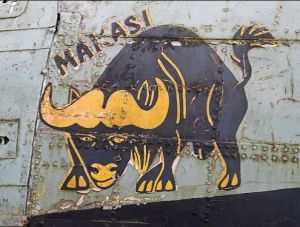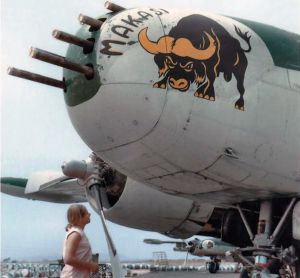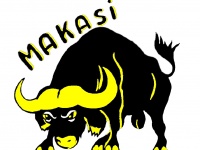211th Squadron: Difference between revisions
No edit summary |
|||
| Line 46: | Line 46: | ||
The squadron itself was a composite squadron that operated out of Leopoldville. All of the planes in the unit bore the Makasi bull emblem on the nose.<br> | The squadron itself was a composite squadron that operated out of Leopoldville. All of the planes in the unit bore the Makasi bull emblem on the nose.<br> | ||
[[File:Makasi on a T-28.jpg|300px]] [[File:Makasi 2.jpg|300px]] | [[File:Makasi on a T-28.jpg|300px]] [[File:Makasi 2.jpg|300px]] [[File:Makasi planes.jpg|300px]] | ||
The first 3 B-26Ks arrived the night of 17 Aug 1964, having been flown in by US pilots from the 602nd Fighter Squadron. The Cuban pilots learned quickly, having some experience on the B-26 already, and flew the first combat mission on 21 Aug 1964.<ref name="Hagedorn"/> Four B-26Bs were originally slated to go to this operation. Of these, 1 was left behind in Okinawa, another crashed and burned in Aden, and the last two arrived in-tact in September 1964. <ref name="Hagedorn"/> The Cubans soon learned that the B-26Bs were no longer used by the Americans and were somewhat outraged over their arrival thinking them to be a deathtrap. One of the planes was never used again, instead becoming a source for spare parts. The other plane had benches installed in the bomb bay and was kept on standby as an emergency escape vehicle. Eventually, desperation and need forced them to refit the plane as a makeshift recon vehicle which the crew jokingly called "U-3" as a tongue-in-cheek reference to the U-2 spyplane.<ref name="Hagedorn"/> | The first 3 B-26Ks arrived the night of 17 Aug 1964, having been flown in by US pilots from the 602nd Fighter Squadron. The Cuban pilots learned quickly, having some experience on the B-26 already, and flew the first combat mission on 21 Aug 1964.<ref name="Hagedorn"/> Four B-26Bs were originally slated to go to this operation. Of these, 1 was left behind in Okinawa, another crashed and burned in Aden, and the last two arrived in-tact in September 1964. <ref name="Hagedorn"/> The Cubans soon learned that the B-26Bs were no longer used by the Americans and were somewhat outraged over their arrival thinking them to be a deathtrap. One of the planes was never used again, instead becoming a source for spare parts. The other plane had benches installed in the bomb bay and was kept on standby as an emergency escape vehicle. Eventually, desperation and need forced them to refit the plane as a makeshift recon vehicle which the crew jokingly called "U-3" as a tongue-in-cheek reference to the U-2 spyplane.<ref name="Hagedorn"/> | ||
Revision as of 01:57, 28 July 2020
| 211th Squadron | |||
|---|---|---|---|
| Air Force: Congolese Air Force | |||
| Group: 2nd Group | |||
| Active: 1964- | |||
| Theater Congo | |||
| Motto: Makasi (Strong) | |||
| Aircraft: C-46, T-28, B-26 | |||
| COMMANDERS | |||
| Group CO: Joaquin "Pupy" Varela | |||
| MAIN BASES | |||
| Air fields: Leopoldville | |||
| Donate | |||
| Even a small donation of a couple of dollars goes a long way in helping | |||
The Makasi Squadron was a composite squadron that operated out of the Congo as part of Operation Anstalt Wigmo. Formally, the unit was the 211th Squadron, 2nd Group, Congolese Air Force. [1] However, unofficially none of the people in the squadron called themselves that. They instead said they were "El Grupo Voluntario Cubano" or the Cuban Volunteer Group.[2] By June 1964 the Squadron had approximately 25 pilots, mostly Cubans. [2]
The B-26s were owned by the USAF, on loan to the CIA, based in the Congo, and flown by Cubans. The squadron had several other planes. Initially the squadron's maintenance was handled by Cubans. However, as the size and scope of the squadron grew the CIA formed a fake Belgian company called Anstalt Wigmo to handle the maintenance. They brought in over 100 European mechanics and armorers to keep the planes airworthy. [2]
The squadron's insignia, a bull, was taken from a popular local brand of beer called Unibar. The name Makasi coming from the Cuban pilots, meaning "Strong" in Lingali, the native language of the Congo. [3]
The squadron itself was a composite squadron that operated out of Leopoldville. All of the planes in the unit bore the Makasi bull emblem on the nose.



The first 3 B-26Ks arrived the night of 17 Aug 1964, having been flown in by US pilots from the 602nd Fighter Squadron. The Cuban pilots learned quickly, having some experience on the B-26 already, and flew the first combat mission on 21 Aug 1964.[2] Four B-26Bs were originally slated to go to this operation. Of these, 1 was left behind in Okinawa, another crashed and burned in Aden, and the last two arrived in-tact in September 1964. [2] The Cubans soon learned that the B-26Bs were no longer used by the Americans and were somewhat outraged over their arrival thinking them to be a deathtrap. One of the planes was never used again, instead becoming a source for spare parts. The other plane had benches installed in the bomb bay and was kept on standby as an emergency escape vehicle. Eventually, desperation and need forced them to refit the plane as a makeshift recon vehicle which the crew jokingly called "U-3" as a tongue-in-cheek reference to the U-2 spyplane.[2]
List of Planes
| USAF S/N | Registry # | Start Date | End Date | Comments |
|---|---|---|---|---|
| B-26 Invaders | ||||
| 44-35890 | 35890 & FL-890 | Sep 1964 | 1966 | B-26B named "U3" used for recon. Scrapped at Kinshasa. [2] |
| A second B-26B was send to the Congo, but it was not used.[2] A third B-26B crashed and burned in Aden on 21 Aug 1964, and a fourth was left behind in Okinawa. [2] | ||||
| 64-17644 | RF644 & FR-644 | 18 Aug 1964 | Jan 1967 | Named "Shit House Mouse"/"Cachita" |
| 64-17645 | RF645 & FR-645 | 18 Aug 1964 | Dec 1966 | Named "Rum Dum" |
| 64-17646 | RF646 & FR-646 | 18 Aug 1964 | Mar 1967 | Named "The Boogie Bogey" |
| 64-17649 | FR-649 | Jan 1965 | Oct 1966 | |
| 64-17662 | FR-662 & FM-662 | Jan 1965 | Feb 1967 | |
| C-46 Commandos | ||||
| 42-3577 | 9T-PLJ | 1966 | 16 Apr 1969 | C-46A-30-CU. Purchased from Transair Sweeden as a wreck after it crashed doing UN transports in the region. Returned to service. Crashed in the Congo River due to fuel starvation killing all 46 souls aboard. [4] |
| 42-3580 | 9Q-CRP | Dec 1967 | 1970 | C-46A-35-CU. Purchased from Fairline Sweeden. Withdrawn from use and stored. [5] |
| 42-96281 | 9Q-CWN | Jun 1968 | 1969 | C-46A-50-CU. Sold to Aero Suppliers Establishment. [6] |
| Some sources suggest a fourth C-46 was used. | ||||
| T-28D Trojan | ||||
| I don't know exactly how many T-28s were with the unit. I will list the data here as I come across it. A lot the information on the T-28s comes from photos. | ||||
| FG-067 | ||||
| FG-282 | ||||
| FG-289 | ||||
| FG-516 | ||||
| FG-576 | ||||
| FB-809 | ||||
| FB-87? | ||||
List of Members
Garcia, Rene [2]
Ponzoa, Gustavo[2]
Peron, Juan C. [7]
Varela, Joaquin "Pupy" [2]
References
- ↑ http://www.t28trojanfoundation.com/congo.html
- ↑ 2.00 2.01 2.02 2.03 2.04 2.05 2.06 2.07 2.08 2.09 2.10 2.11 Hagedorn, Dan and Hellstrom, Leif, (Midland Publishing, 1994), Foreign Invaders- The Douglas Invader in foreign military and US clandestine service. ISBN 1-85780-013-3. Pg. 149-155
- ↑ http://kosubaawate.blogspot.com/2016/01/leopoldville-1957-battle-of-breweries.html
- ↑ http://curtisscommando.e-monsite.com/pages/aircraft/s-n-42-3564-to-42-3577-curtiss-c-46a-30-cu-commando/commando-42-3577.html
- ↑ http://curtisscommando.e-monsite.com/pages/aircraft/s-n-42-3578-to-42-3683-curtiss-c-46a-35-cu-c-46a-36-cu-commando/commando-42-3580.html
- ↑ https://www.planelogger.com/Aircraft/Registration/9Q-CWN/772015
- ↑ Personal Correspondence

